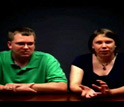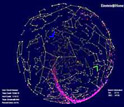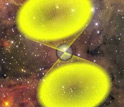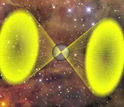News Release 10-140
Citizen Scientists Discover Rotating Pulsar
Einstein@Home project uses data from Arecibo, the world's largest and most sensitive radio telescope
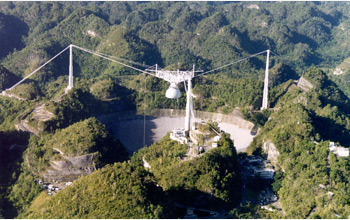
Arecibo Observatory, an NSF facility operated by Cornell University, is in Arecibo, Puerto Rico.
August 12, 2010
View a webcast with the citizen scientists who discovered a rotating pulsar, the Einstein@Home director, and an Arecibo researcher; artist's simulations of the pulsar viewed from the Earth and from the side; and the pulsar's audio signal.
This material is available primarily for archival purposes. Telephone numbers or other contact information may be out of date; please see current contact information at media contacts.
Idle computers are the astronomers' playground: Three citizen scientists--an American couple and a German--have discovered a new radio pulsar hidden in data gathered by the Arecibo Observatory. This is the first deep-space discovery by Einstein@Home, which uses donated time from the home and office computers of 250,000 volunteers from 192 different countries. This is the first genuine astronomical discovery by a public volunteer distributed computing project. The details of their discovery and the process of getting there are revealed in a paper published in the Aug. 12 edition of Science Express.
The new pulsar--called PSR J2007+2722--is a neutron star that rotates 41 times per second. It is in the Milky Way, approximately 17,000 light years from Earth in the constellation Vulpecula. Unlike most pulsars that spin as quickly and steadily, PSR J2007+2722 sits alone in space, and has no orbiting companion star. Astronomers consider it especially interesting since it is likely a recycled pulsar that lost its companion. However they cannot rule out that it may be a young pulsar born with an lower-than-usual magnetic field.
Chris and Helen Colvin, of Ames, Iowa, and Daniel Gebhardt, of Universität Mainz, Musikinformatik, Germany, are credited with this discovery. Their computers, along with half a million others from around the world, are harnessed to analyze data for Einstein@Home (volunteers contribute about two computers each).
Einstein@Home--based at the Center for Gravitation and Cosmology at the University of Wisconsin-Milwaukee, and at the Max Planck Institute for Gravitational Physics, Albert Einstein Institute (AEI), Hannover, Germany--has been searching for gravitational waves in data from the U.S. based LIGO (Large Interferometer Gravitational Observatory) since 2005. Starting in March of 2009, Einstein@Home also began searching for signals from radio pulsars in astronomical observations from the Arecibo Observatory in Puerto Rico. Arecibo, a National Science Foundation (NSF) facility operated by Cornell University, is the world's largest and most sensitive radio telescope. About one-third of Einstein@Home's computing capacity is used to search Arecibo data.
"This is a thrilling moment for Einstein@Home and our volunteers. It proves that public participation can discover new things in our universe. I hope it inspires more people to join us to help find other secrets hidden in the data," said Bruce Allen, leader of the Einstein@Home project, Max Planck Institute director and adjunct professor of physics at the University of Wisconsin-Milwaukee.
The paper, "Pulsar Discovery by Global Volunteer Computing," is authored by Allen's graduate student, Benjamin Knispel from the AEI; Bruce Allen; James M. Cordes, Cornell professor of astronomy and chair of the Pulsar ALFA Consortium; and an international team of collaborators. It details the pulsar and announces the first genuine astronomical discovery by a public volunteer distributed computing project.
"No matter what else we find out about it, this pulsar is bound to be extremely interesting for understanding the basic physics of neutron stars and how they form. Its discovery has required a complex system that includes the Arecibo Telescope and computing resources at the Albert Einstein Institute, at the Cornell Center for Advanced Computing, and at the University of Wisconsin-Milwaukee to be able to send data out worldwide to Einstein@Home volunteers," Cordes said. The Arecibo Observatory is funded by the NSF, which collaborates with the Max Planck Gesellschaft to support Einstein@Home.
"This is an exciting development that highlights the importance of citizen science, as well as the partnerships and discoveries that arise when scientific data are shared," said Ed Seidel, assistant director for NSF's directorate for Mathematical and Physical Sciences. "Having previously led a research group at the AEI myself, I deeply understand the importance of international collaborations such as this," he added.
Additional Background Material
Gravitational waves were first predicted by Einstein in 1916 as a consequence of his general theory of relativity, but they have not yet been directly detected. Einstein@Home was developed as part of the World Year of Physics 2005 activities of the American Physical Society and the Einstein Jahr 2005 activities of the Albert Einstein Institute. For the past five years, Einstein@Home has been searching for gravitational waves in data from the U.S. LIGO detectors.
Radio pulsars are rapidly spinning neutron stars that emit lighthouse-like beams of radio waves that can sweep past the Earth as often as 716 times per second. They were discovered in 1967 by Jocelyn Bell and Antony Hewish. (Coincidentally, the first one to be discovered was also in the constellation of Vulpecula.) Pulsars that have orbiting companions are called binary pulsars. They have been used to verify Einstein's theory of general relativity to very high precision.
Disrupted Recycled Pulsar: When two massive stars are born close together from the same cloud of gas, they can form a binary system and orbit each other from birth. If those two stars are at least a few times as massive as our sun, their lives will both end in supernova explosions. The more massive star explodes first, leaving behind a neutron star. If the explosion does not kick the second star away, the binary system survives. The neutron star can now be visible as a radio pulsar, and it slowly loses energy and spins down. Later, the second star can swell up, allowing the neutron star to suck up its matter. The matter falling onto the neutron star spins it up and reduces its magnetic field. This is called "recycling" because it returns the neutron star to a quickly-spinning state. Finally, the second star also explodes in a supernova, producing another neutron star. If this second explosion also fails to disrupt the binary, a double neutron star binary is formed. Otherwise, the spun-up neutron star is left with no companion and becomes a "disrupted recycled pulsar", spinning between a few and 50 times per second.
Arecibo Observatory, an NSF facility operated by Cornell University, is the largest single-dish radio telescope on the planet, and is used for studies of pulsars, galaxies, solar system objects, and the Earth's atmosphere. The first binary pulsar was discovered at Arecibo in 1974 and led to Hulse and Taylor's 1993 Nobel Prize in Physics, because of its stringent test of general relativity. The Pulsar ALFA (PALFA) survey now being conducted at Arecibo uses a specialized radio camera, the Arecibo L-band Feed Array, and is conducted by the PALFA Consortium of astronomers. The large data sets from the Arecibo survey are archived and processed initially at Cornell and other PALFA institutions. For the Einstein@Home project, data are sent from the Cornell Center for Advanced Computing to the Albert Einstein Institute (AEI) in Hannover via high-bandwidth Internet links, pre-processed and then distributed to computers around the world. The results are returned to AEI and Cornell for further investigation.
The Pulsar ALFA (PALFA) Consortium was formed in 2003 to conduct a large scale pulsar survey with the Arecibo telescope. It includes astronomers at twenty universities, institutes and observatories worldwide.
The Max Planck Institute for Gravitational Physics (Albert Einstein Institute) is the largest research institute in the world devoted to the study of general relativity. Its two branches in Potsdam and Hannover support research in astrophysics, theoretical physics, mathematics, and experimental physics. The AEI Hannover is a joint undertaking of the Max Planck Society and the Leibniz Universität Hannover. Together with British partners it operates the GEO600 gravitational wave detector near Hannover, Germany, is a partner in the American LIGO project, and plays a major role in the analysis of the data from all existing gravitational wave detectors, including the VIRGO detector in Italy. The software that is used in the Einstein@Home radio searches was developed by the AEI in Hannover.
The Center for Gravitation and Cosmology at the University of Wisconsin-Milwaukee hosts the Einstein@Home project and plays a major role in the data analysis activities of the LIGO Scientific Collaboration. It also carries out Arecibo radio observations as an Arecibo Remote Control Center (ARCC).
BOINC is the Berkeley Open Infrastructure for Network Computing used by Einstein@Home and many other volunteer computing projects like SETI@Home. It was developed at the University of California at Berkeley's Space Sciences Laboratory, in an effort led by Dr. David Anderson.
Funding: The U.S. National Science Foundation supports this work through grants to the Einstein@Home project, to the PALFA project, to the BOINC project at the University of California, Berkeley, and through a cooperative agreement with Cornell University to operate the Arecibo Observatory. The Max Planck Institute for Gravitational Physics (Albert Einstein Institute) is supported by the Max Planck Society and the Leibniz Universität Hannover.
-NSF-
-
View Video
First genuine astronomical discovery made by German and American Einstein@Home volunteers.
Credit and Larger Version -
Einstein@Home screen shot.
Credit and Larger Version -
Inside the dome of the Arecibo Observatory in Puerto Rico is the pulsar detector, PALFA.
Credit and Larger Version -
Artist's rendition of the position of the discovered pulsar (red circle).
Credit and Larger Version -
View Video
Artist's simulation of the discovered pulsar as seen from the Earth.
Credit and Larger Version -
View Video
Artist's simulation of the newly discovered pulsar, as viewed sideways.
Credit and Larger Version -
Play Audio
The pulsar's radio signal waveform as an audio signal.
Credit and Larger Version -
This paper appears in the Aug. 12 online journal Science Express.
Credit and Larger Version
Media Contacts
Lisa-Joy Zgorski, NSF, (703) 292-8311, email: lisajoy@nsf.gov
James Riordon, American Physical Society, {301) 209-3238, email: riordon@aps.org
Robert Sanders, University of California, Berkeley, (510) 643.6998, email: rlsanders@berkeley.edu
Blaine Friedlander, Arecibo Observatory / Cornell University, (607) 254.8093, email: bpf2@cornell.edu
Felicitas Mokler, Max Planck Institute for Gravitational Physics (AEI), 49.511.762.17098, email: felicitas.mokler@aei.mpg.de
Program Contacts
Dana E. Lehr, NSF, (703) 292-7456, email: dlehr@nsf.gov
Beverly Berger, NSF, (703) 292-7372, email: bberger@nsf.gov
Principal Investigators
James Cordes, Cornell University, (607) 255-0608, email: cordes@astro.cornell.edu
Bruce Allen, Max Planck Institute, 49 511 762 17145, email: bruce.allen@aei.mpg.de
Co-Investigators
David Anderson, U.C. Berkeley Space Sciences Laboratory, (510) 642-4921, email: davea@ssl.berkeley.edu
Related Websites
BOINC: http://boinc.berkeley.edu/
Arecibo Observatory: http://www.naic.edu/
Einstein@Home: http://einstein.phys.uwm.edu/
LIGO Scientific Collaboration: http://www.ligo.org/
Cornell Center for Advanced Computing:: http://www.cac.cornell.edu/
Pulsar Arecibo L-band Feed Array (PALFA) Consortium: http://arecibo.tc.cornell.edu/PALFA/
Einstein@Home Arecibo Radio Pulsar search: http://einstein.phys.uwm.edu/radiopulsar/html/index.php
Max Planck Institute for Gravitational Physics (Albert Einstein Institute): http://www.aei.mpg.de/
The U.S. National Science Foundation propels the nation forward by advancing fundamental research in all fields of science and engineering. NSF supports research and people by providing facilities, instruments and funding to support their ingenuity and sustain the U.S. as a global leader in research and innovation. With a fiscal year 2023 budget of $9.5 billion, NSF funds reach all 50 states through grants to nearly 2,000 colleges, universities and institutions. Each year, NSF receives more than 40,000 competitive proposals and makes about 11,000 new awards. Those awards include support for cooperative research with industry, Arctic and Antarctic research and operations, and U.S. participation in international scientific efforts.
Connect with us online
NSF website: nsf.gov
NSF News: nsf.gov/news
For News Media: nsf.gov/news/newsroom
Statistics: nsf.gov/statistics/
Awards database: nsf.gov/awardsearch/
Follow us on social
Twitter: twitter.com/NSF
Facebook: facebook.com/US.NSF
Instagram: instagram.com/nsfgov



